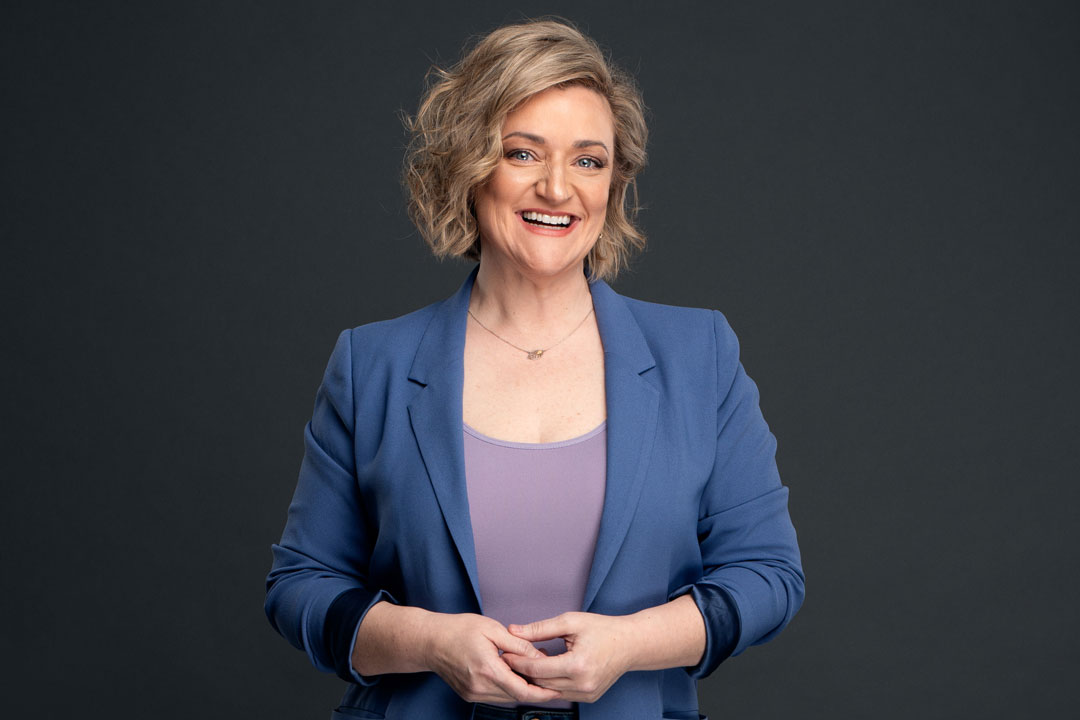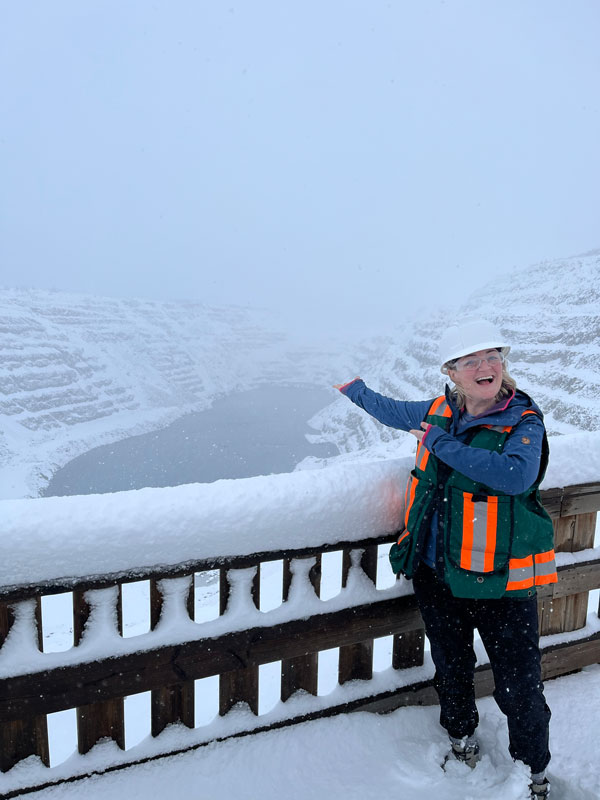
‘Turning curiosity into action’
Award-winning USask graduate Dr. Monique Simair (BSc’04, PhD’09) has leveraged her passion for science, innovation, and problem-solving into two successful environmental consultancy businesses
By SHANNON BOKLASCHUKUniversity of Saskatchewan (USask) graduate Dr. Monique Simair (BSc’04, PhD’09) is an entrepreneur, scientist, innovator, and industry leader in the environmental consulting sector who is known for developing water treatment strategies for mining projects in Canada and around the world.
Following Integrated Sustainability’s acquisition of her second company, Maven Water and Environment, Simair stepped into the role of Vice President of Science and Innovation, bringing her expertise in commercializing new environmental technologies into the organization’s next phase of growth. The company—which has offices in Saskatoon, Vancouver, Calgary, California, and Barbados—provides sustainable infrastructure engineering and consulting solutions to address today’s water, waste, and energy challenges.
Simair—who is also an adjunct professor in USask’s College of Engineering—has long had an interest in science; she studied microbiology and immunology at USask’s College of Arts and Science before earning her PhD in applied microbiology at USask’s College of Medicine. Shortly after completing her doctorate, Simair took a job at the Saskatchewan Research Council, which further sparked her interest in business and developing sustainable technologies.
“Although I spent less than a year there, I got my first taste of consulting—working with clients to solve real-world problems—and it clicked. I realized I could blend my love of science with my knack for problem-solving to make a tangible impact,” she said.

“Water treatment in mining grabbed me because it’s complex and critical; mines are like mini cities of expertise, and I thrived on asking questions and finding innovative solutions. It’s still what drives me: using science to tackle challenges and help industries operate sustainably.”
Since then, Simair has become a successful entrepreneur, launching her first company, Contango Strategies, in 2010, followed by Maven Water and Environment in 2019. In 2011, Simair was named one of Canada's future entrepreneurial leaders by Profit Magazine and was added to Chatelaine’s W100 list of Canada’s top female entrepreneurs in 2015. In 2020, she was honoured as one of the College of Arts and Science’s Alumni of Influence Award recipients. She was also named as Canada’s Eco Impact Winner in 2021, and her business, Maven Water and Environment, was awarded the title of Saskatchewan’s Business of the Year in 2022.
The Green&White recently talked to Simair about her education at USask, her support for women in STEM (science, technology, mathematics, and engineering), her entrepreneurial innovation, and her advice for other USask alumni who may be interested in starting their own businesses.
You obtained a Bachelor of Science degree in microbiology and immunology at USask’s College of Arts and Science, followed by a PhD from the College of Medicine. What inspired you to pursue your education in science?
Growing up in northern Saskatchewan, I was surrounded by nature; our large family garden, endless hikes, and camping trips shaped my early years. With no internet and just two TV channels, my entertainment came from exploring the outdoors or diving into second-hand encyclopedias and National Geographic magazines gifted by neighbours. That simplicity fuelled my curiosity about how the world works and sparked my imagination about what could be. My parents encouraged me to ask questions and figure things out, which became second nature. When I started my undergrad at USask in 2000, I initially leaned toward a pre-med path, not because I fully understood what being a doctor entailed, but because I didn’t know what else a science degree could lead to. Then, by chance, I took a microbiology elective and the professor’s passion, paired with the subject’s intrigue, hooked me. It was a scheduling fluke that turned into a defining moment, steering me toward microbiology and immunology, and later my PhD in applied microbiology.
What was the best part of studying at USask?
The USask campus is a gem—its beauty, from the historic architecture to the sprawling green spaces, made every day inspiring. I loved having room to roam and think. The class sizes were a huge bonus, too. My first couple of years had those big lectures with hundreds of students, but by third and fourth year, I was in classes of 15 to 25. That shift opened up dynamic group discussions and hands-on lab work where I could really dig into the material and connect with peers and professors. It felt like a community of curiosity, and that balance of scale—big enough to challenge you, small enough to feel personal—was perfect for me.
Since graduating, you have developed a few new water treatment technologies. What are those technologies, and how are they making a difference in water treatment?
I’ve had the privilege of leading teams to create some game-changing technologies. Back in 2011, with Contango Strategies, we launched the first commercial environmental genomics services—a DNA test for environmental bacteria. It reveals what microbes are present, what contaminants they can break down, and how to optimize their “diet” to get the job done. On the treatment side, I designed the Gravel Bed Bioreactors (mBio Bioreactors), first built in 2018 for a gold mine in Ontario. These systems treat over 20 million litres of tailings water daily, removing metals and pollutants through biological processes. Then there’s mGrow Constructed Wetlands, which mimic natural ecosystems to clean mine and oilsands water, and mSource, an in-situ treatment approach that tackles contamination right at the source. These semi-passive solutions cut carbon footprints and operational costs while delivering reliable, scalable water management—revolutionizing how industries like mining protect our water systems. My latest undertaking is to expand these technologies to work for treatment of my favourite element—selenium.

In addition to being a scientist and innovator, you are also an entrepreneur who has successfully built and sold two companies. Through your first company, Contango Strategies, you developed the first commercial genomics services for environmental microbiology communities. That work revolutionized understanding across the sector of bioreactor processes as well as biological treatment mechanisms and opportunities. What did you learn from starting this innovative business?
I spotted a gap in the resource sector for lab-based consulting and pilot-scale testing, and I jumped in with zero business experience. It was a crash course in everything: accounting, insurance, HR—you name it, I had to figure it out. My PhD taught me how to learn, though, so I wasn’t fazed by the chaos. I discovered that business isn’t so different from science—accounting mirrors chemical equations, just with dollars instead of molecules. The biggest lesson? Resilience and adaptability. We turned unconventional ideas, like applying medical genomics to environmental challenges, into a multimillion-dollar company because I wasn’t afraid to rethink the playbook. It showed me that innovation thrives when you’re bold enough to bridge worlds others don’t see as connected.
Your second business, Maven Water and Environment, has just been sold, officially joining Integrated Sustainability as of Jan. 1, 2025. What does this mean for you, for the company, and for sustainable water management?
This merger is a thrilling leap forward. At Maven, we’ve been pushing the envelope with technologies like bioreactors and constructed wetlands—but scaling them up often stalled because traditional engineering firms shy away from uncharted territory. Integrated Sustainability, our close collaborator of five years, gets it—they’ve got the grit and expertise to turn our concepts into reality. For me, it’s a chance to focus on what I love: innovating and solving problems, now with a bigger sandbox to play in. For Maven, it’s growth—our team and tech are merging with a firm that can execute at scale, expanding into oil and gas, industrial, and municipal sectors. For sustainable water management, it’s a powerful combination: Maven’s commercialization of environmental technologies and cutting-edge testing services, paired with Integrated Sustainability’s engineering and advisory muscle. Together, we’re poised to set new standards in water treatment worldwide.
What advice do you have for USask alumni who may be considering starting a new business?
You can’t steer a bicycle that’s not moving. Don’t get paralyzed perfecting a plan; the early days of a business shift fast, so launch with a minimum viable product and refine as you go. Keep it lean—streamline everything to focus on what matters. Location is key: where are your clients and talent pool? Look into provinces or cities with incentives or funding; Saskatoon’s ecosystem gave me a leg up, but moving might be your edge. And don’t go it alone. Unlike when I started in 2010, there’s a wealth of resources now—mentors, programs, networks—but vet the advice. Has your advisor built something like what you’re aiming for? Relevance matters. Momentum, simplicity, and the right support can turn an idea into something unstoppable.
You are passionate about shining a light on women in STEM (science, technology, engineering, and mathematics). What advice do you have for other women who may want to enter a STEM field?
Know yourself and own your path. STEM can feel intimidating—sometimes it’s subtle, sometimes it’s overt—but don’t let anyone define your ambitions. Early on, I didn’t see the hurdles as gendered; now I recognize how many I cleared. My advice? Find your niche where you shine—mine was in multidisciplinary problem-solving—and then chase it relentlessly. Seek out allies, not just mentors; I’ve built teams with over 80 per cent women because collaboration beats isolation. And don’t fear pivoting—STEM is vast, and your goals can evolve. The world needs your voice, so step in, ask questions, and build what excites you. It’s not about fitting in; it’s about standing out.
How has your USask education been of benefit to you as a scientist and entrepreneur?
USask gave me a toolbox I didn’t even know I’d need. The science curriculum was broad and flexible—I took courses across disciplines, which left me with a degree that didn’t neatly fit the job market but taught me how to think critically and adapt. That resilience was gold when I started companies in fields I barely understood at first. The smaller class sizes and Saskatoon’s tight-knit community also built a network I leaned on later—my professors and peers became sounding boards as I grew Contango and Maven. It wasn’t just the science; it was the problem-solving mindset and connections that let me bridge academia and industry, turning curiosity into action.


